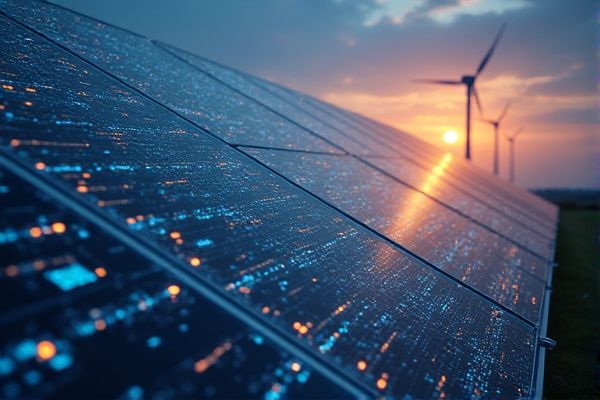
Artificial intelligence enhances the efficiency of renewable energy systems by optimizing energy production through predictive analytics. Smart grid technologies utilize AI algorithms to forecast energy demand and supply, allowing for better integration of renewable sources like solar and wind. Machine learning models analyze vast amounts of data to predict equipment failures, facilitating timely maintenance and reducing downtime. AI-driven energy management systems can intelligently balance loads and storage, maximizing the use of clean energy while minimizing reliance on fossil fuels.
AI usage in renewable energy systems
Predictive Maintenance
AI can enhance predictive maintenance in renewable energy systems by analyzing data from various sources, such as wind turbines and solar panels. This predictive capability may result in reduced downtime and extended equipment lifespan. For instance, a solar farm can utilize AI algorithms to forecast potential failures, allowing for proactive repairs. Such advancements could lead to significant cost savings and improved efficiency in energy production.
Energy Demand Forecasting
AI can improve energy demand forecasting in renewable energy systems by analyzing historical usage patterns and weather data. For instance, utilities like Pacific Gas and Electric leverage AI algorithms to predict fluctuations in energy demand. This predictive capability allows for more efficient energy distribution and reduces waste. Enhanced forecasting also opens opportunities for integrating various renewable sources, such as solar and wind, into the energy grid.
Smart Grid Management
AI can optimize renewable energy production by predicting energy output from sources like solar panels and wind turbines. In Smart Grid Management, AI algorithms can balance supply and demand, enhancing grid stability and efficiency. The integration of AI may reduce operational costs and improve the reliability of energy systems. Institutions like MIT are exploring these advanced technologies to further enhance energy solutions.
Renewable Resource Optimization
AI can enhance renewable energy systems by optimizing the allocation and use of resources. For example, predictive algorithms can analyze weather patterns to improve the efficiency of wind turbines at institutions like MIT. These advancements increase the possibility of reducing energy costs and maximizing output. Embracing AI in this context offers a chance for more sustainable energy solutions and better resource management.
Energy Efficiency Analysis
AI can enhance the efficiency of renewable energy systems by predicting energy generation patterns and optimizing grid management. For instance, energy forecasting models utilized by institutions like the National Renewable Energy Laboratory (NREL) can lead to better utilization of solar and wind resources. The analysis of energy efficiency can be improved through AI-driven algorithms that assess consumption patterns in real-time. This provides opportunities for reducing waste and lowering operational costs in various energy sectors.
Power Load Balancing
AI can optimize power load balancing in renewable energy systems by predicting energy demand and adapting resource distribution efficiently. For instance, integrating AI algorithms can enhance the performance of wind farms by accurately forecasting wind patterns and turbine output. This leads to minimized energy waste and improved grid reliability. The potential advantages include cost savings and increased sustainability for energy providers like Siemens Gamesa.
Anomaly Detection
AI can enhance anomaly detection in renewable energy systems, leading to improved efficiency and reduced downtime. For instance, wind farms can benefit from AI algorithms that monitor turbine performance and identify unusual patterns early. This predictive capability allows for timely maintenance and operational adjustments, potentially increasing energy output. Companies investing in such technologies may gain a competitive edge by optimizing their resources and minimizing operational costs.
Autonomous Energy Trading
AI usage in renewable energy systems can enhance efficiency by optimizing energy production and consumption. For instance, autonomous energy trading platforms can analyze market trends and weather patterns to predict energy prices and demand. This predictive capability allows for better allocation of resources, reducing waste and costs. As a result, entities like power plants could benefit from increased profitability and sustainability in their operations.
Emission Reduction Strategies
AI can enhance the efficiency of renewable energy systems through predictive analytics and real-time data processing. For instance, utilities like NextEra Energy can leverage AI to optimize energy production and consumption patterns. This can lead to significant emission reductions by maximizing the use of clean energy sources such as solar and wind. The possibility of integrating AI algorithms into existing infrastructure offers a chance for substantial advancements in sustainability efforts.
Real-time Data Analytics
AI can enhance renewable energy systems by optimizing energy production and consumption patterns. For instance, real-time data analytics can predict energy demand and adjust supply accordingly, leading to improved efficiency and reduced waste. Companies like Siemens are exploring these technologies to better manage their energy distribution networks. The integration of AI could potentially lower operational costs and increase the overall effectiveness of renewable energy sources.
 techknowy.com
techknowy.com